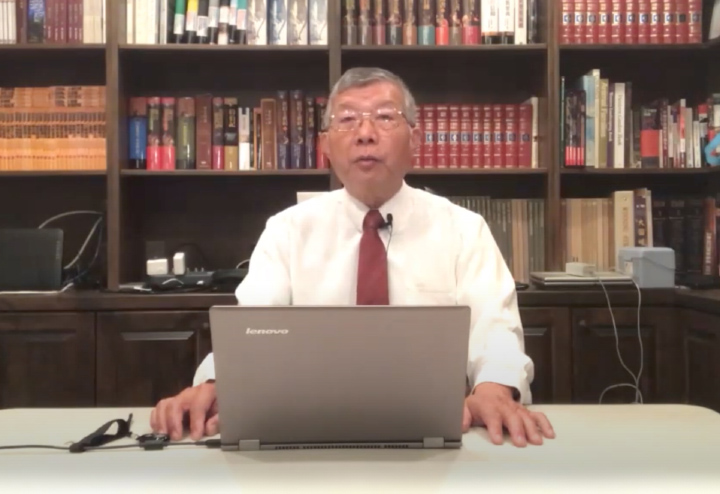Bother Hsieh Introduction
 Brother Hsieh Wen-Jai graduated from the Department of Electrical Engineering, National Taiwan University, and was engaged in the development of chip design software in California's Silicon Valley in the early 1980s. In 1986, he was sent by the company to the Hsinchu Science Park in Taiwan to establish an R&D center, which was the earliest and only chip design software for the company. In 1990, a chip design company was established in Silicon Valley. He retired in 1999 and was called by God to set up China Soul for Christ Foundation together with Pastor Yuan Zhiming as director-general. So far, he is one of the first people to participate in Chinese Christian gospel film and television. During this time, he also participated in the establishment of the "Smyrna Training Information Center" to produce film and television teaching materials for Sunday school use. He is also a former elder of the "Mountain View Christian Church" in California, USA. During his time as elder, he began to explain the Gospel of Luke chapter by chapter and sorted out related sermons in the way of expository preaching. After retiring as elder, and in response to the needs of the Chinese house churches, brother Hsieh took about two years to organize and complete all the sermons in Chapter 24 of the Gospel of Luke, and began to produce this series of sermons during the period of home isolation in 2020. This sermon series can be used for Sunday message and for group family gatherings.
Brother Hsieh Wen-Jai graduated from the Department of Electrical Engineering, National Taiwan University, and was engaged in the development of chip design software in California's Silicon Valley in the early 1980s. In 1986, he was sent by the company to the Hsinchu Science Park in Taiwan to establish an R&D center, which was the earliest and only chip design software for the company. In 1990, a chip design company was established in Silicon Valley. He retired in 1999 and was called by God to set up China Soul for Christ Foundation together with Pastor Yuan Zhiming as director-general. So far, he is one of the first people to participate in Chinese Christian gospel film and television. During this time, he also participated in the establishment of the "Smyrna Training Information Center" to produce film and television teaching materials for Sunday school use. He is also a former elder of the "Mountain View Christian Church" in California, USA. During his time as elder, he began to explain the Gospel of Luke chapter by chapter and sorted out related sermons in the way of expository preaching. After retiring as elder, and in response to the needs of the Chinese house churches, brother Hsieh took about two years to organize and complete all the sermons in Chapter 24 of the Gospel of Luke, and began to produce this series of sermons during the period of home isolation in 2020. This sermon series can be used for Sunday message and for group family gatherings.
Introduction to the Prophets
Reading the prophets we often need to "build bridges" across at least six unavoidable gaps and difficult to understand obstacles; this is historical (Ho 9:9; Az 14:5) and cultural (Ho 7:8; Ho 7:8; Eze. 21:21), linguistic (Ho 2:16), geographical (Ho 2:14,15; Joshua 7:26), biological (Ho 14:5-8), and psychological gap (Ho 11 :8; Sorrow 1:12; 2:15), and the psychological gap is the most important and the most difficult to bridge.
There are three words to describe a prophet in Hebrew, which we usually translate as "prophet" or "seeker"; (1 Chronicles 29:29). The three Hebrew words are "Nabhi" (declaration), "Hozeh" (watcher), and "Roen" (watcher). They describe the title of the prophet, which is the "watcher"; watch what happens outside the city And explain. When you see danger, call the police to the people in the city. This also defines the duty of the prophet, which is "watching" and "warning."
The writing of the Old Testament prophets can basically be divided into three periods. In the first period there are Hosea, Joel, Amos, Isaiah and Micah. This period was basically affected by the Assyrian Empire (930-612BC). The prophets of the second period include Jeremiah, Lamentations, Obadiah, Ezekiel and Daniel; that is, the Babylonian Empire (612-538BC) and the early days of the Persian Empire. The prophets of the third period included Haggai, Malachi, and Zechariah; the world power at that time was the Persian Empire (538-332BC).
The most important book of all prophets is Isaiah. If we can grasp the information of Isaiah, we will have a map that will lead us to read other prophets. And you need to pay attention to these four themes when reading the book of Isaiah:
1) The Grace of God (The Grace of God) since ancient times
2) The rebellion of the human hearts
3) The Judgment of God
4) Kingdom’s Glory and Hope (Kingdom’s Glory and Hope)
The book of Isaiah can basically be divided into four parts; (Isaiah 1-5) opened the preface of the whole book with a court scene. (Isaiah 6-35) mainly talks about God's judgment and the day of God's revenge, and (Isaiah 6) can be said to be the beginning of Isaiah. (Isaiah 36-37) recorded the siege of Jerusalem and Hezekiah’s illness (Isaiah 38-39); basically the same chronicle (2 Kings 18-20; 2 Chronicles 32). And (Isaiah 40-66) is the final paragraph; in this paragraph (Isaiah 40-48) talks about the attributes of God; (Isaiah 49-57) talks about the Redeemer; and (Isaiah 58-66) When talking about the redeemed, the focus is on the nature and ending of the believer.






